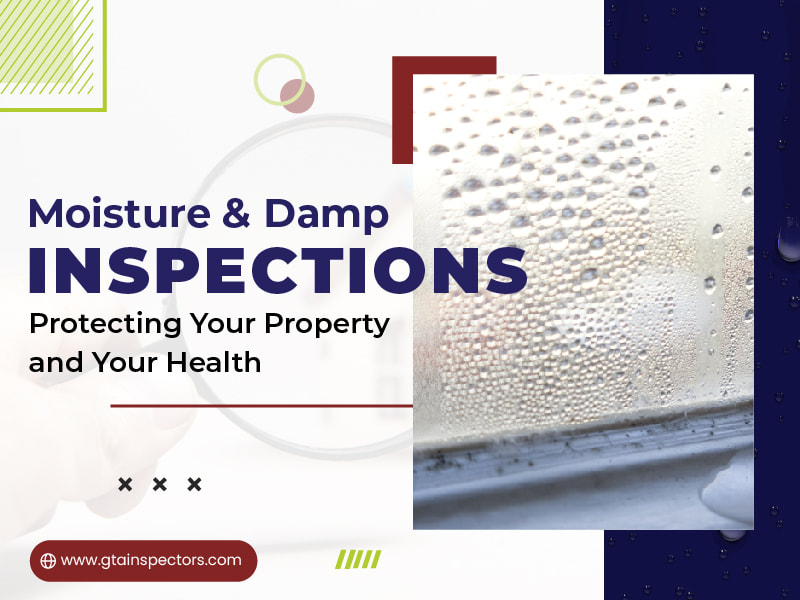|
Dampness can be a persistent and damaging issue for homeowners, leading to structural damage, mold growth, and many other problems. Investing in quality waterproofing materials is crucial to safeguard your property against the insidious effects of moisture.
This guide will explore various waterproofing solutions that can help you keep your home dry and structurally sound. You can also hire a professional property inspector to inspect your home and track down the issues in the property. 1. Understanding the Impact of Dampness: Dampness in a home can arise from various sources, including leaks, rising dampness, and condensation. Left unaddressed, it can result in structural decay, compromised indoor air quality, and health issues. To fortify your property against these risks, it's essential to choose the right waterproofing materials. 2. Exterior Waterproofing Membranes: One of the first lines of defense against dampness is exterior waterproofing membranes. Foundation walls are protected from water penetration by this membrane. Materials like bituminous coatings or elastomeric membranes are popular, providing flexibility and durability. 3. Polyurethane Sealants: Ideal for sealing joints and cracks, polyurethane sealants offer excellent waterproofing properties. They are versatile and adhere well to various surfaces, making them suitable for interior and exterior applications. Polyurethane sealants expand and contract with the building materials, ensuring a long-lasting seal against water intrusion. 4. Basement Waterproofing Paint: Basement walls are particularly vulnerable to dampness. Waterproofing paints create a protective barrier, preventing water from seeping through the porous surfaces. These paints often contain additives that enhance mold resistance, offering additional protection for your basement. 5. Cementitious Waterproofing: Cementitious waterproofing is a versatile solution for both new and existing structures. This material is a cement-based coating that forms a waterproof barrier when applied to concrete surfaces. It is commonly used in areas prone to high humidity or where direct water exposure is a concern, such as basements and bathrooms. 6. Waterproofing Membranes for Roofs: If roof leaks are not addressed promptly, they can cause extensive damage. Waterproofing membranes for roofs, such as asphaltic or synthetic rubber membranes, provide a durable and resilient shield against water infiltration. Regular roof inspections coupled with applying these membranes can significantly extend the lifespan of your roof. You can also use the help of snagging company Dubai to track down the leaks. 7. Interior Drainage Systems: In areas where water accumulation is a persistent issue, installing interior drainage systems can be an effective solution. These systems, such as French drains, help redirect water away from the foundation, preventing it from seeping into the basement. Combined with sump pumps, interior drainage systems offer a comprehensive defense against groundwater. 8. Damp-Proofing Courses: Damp-proofing courses involve installing materials, often bitumen-based or plastic, to create a barrier against rising dampness. Placed within the structure's walls, these courses inhibit the upward movement of moisture, protecting the building from the ground up. Investing in quality waterproofing materials is an investment in your property's structural integrity and longevity. Whether you're dealing with a leaky basement, a compromised roof, or rising dampness, the right waterproofing solution can mitigate these issues and provide lasting protection. Regular maintenance, certified property inspections, and timely application of waterproofing materials will keep your home dry and safeguard its value for years to come. Your property will be safer and more comfortable if you fortify it against dampness.
0 Comments
Congratulations on your decision to purchase a new home! This exciting journey, snagging inspection, is a crucial step in home buying. The snagging inspection is one of the most critical steps in the home-buying process as you embark on this exciting journey.
A thorough inspection can unveil hidden issues and help you make an informed decision. To ensure you get the most out of this process, asking the right questions is essential. In this blog post, we'll explore some crucial inquiries to make during your home inspection, empowering you to make a well-informed decision on your prospective property. What Does the Inspection Cover? Begin by understanding the scope of the inspection. A comprehensive inspection should cover structural elements, roofing, plumbing, electrical systems, heating and cooling systems, insulation, ventilation, and more. Ensure the inspector provides a detailed list of what they will assess to ensure no crucial aspect is overlooked. Can I Attend the Inspection? Being present during the inspection allows you to observe firsthand and ask questions as the professional property inspector evaluates the property. It's an excellent opportunity to get insights into the home's condition and understand potential issues. What are the Most Critical Issues Found? While the inspector may provide you with a detailed report, asking about the most critical issues discovered during the inspection can help prioritize concerns. This information can guide negotiations with the seller or help you decide if the property fits you. Are There Any Immediate Repairs or Safety Concerns? Understanding if there are any urgent repairs or safety issues is crucial. Identifying these problems early ensures you can address them promptly, preventing potential hazards and saving you from unexpected expenses. How Long Will the Home's Major Components Last? Inquire about the estimated lifespan of critical components like the roof, HVAC system, and appliances. This information can help you plan for future maintenance and replacements, providing a clearer picture of the property's long-term viability. Are There Any Signs of Water Damage or Moisture Issues? Water damage can lead to many problems, from mold growth to structural damage. Ask the inspector about signs of water damage, including leaks, stains, or mold. Understanding the potential for moisture-related issues can help you take preventive measures. What Maintenance Tips Can You Provide? A good home inspector will identify existing issues and offer valuable maintenance tips. Learning about the proper care and upkeep of your future home can extend its lifespan and save you money in the long run. Can You Estimate the Cost of Repairs for Identified Issues? While the inspector may not provide exact cost estimates, they can offer a general idea of the potential expenses associated with the repairs needed. This information is crucial for budgeting and negotiating with the seller. Is the Home Energy Efficient? In today's environmentally conscious world, understanding the energy efficiency of your potential home is essential. Inquire about the insulation, windows, and energy-efficient features that can impact your utility bills and overall comfort. What Should I Keep an Eye on Between Inspections and Closing? Closing on a home can take some time, and things may change between the residential property inspection and the closing date. Ask your inspector for advice on what to monitor or any additional steps you should take to ensure the property's condition doesn't deteriorate. In conclusion, a residential property inspection is crucial in home-buying, providing valuable insights into the property's condition. By asking these essential questions, you empower yourself to make informed decisions, negotiate effectively, and ensure a smooth transition into your new home. Investing in knowledge pays off, especially when it comes to finding your dream home. Happy home hunting! In the dynamic world of interior design, creating spaces that seamlessly blend aesthetics with functionality is an art form. Interior designers strive to transform houses into homes, tailoring each element to reflect the client's personality and lifestyle.
However, amidst the flurry of fabric swatches and color palettes, there's a crucial step that often goes unnoticed – home inspections. While traditionally associated with real estate transactions, snagging inspection offers a wealth of benefits for interior designers. Let's delve into the ways these inspections become invaluable tools in the hands of design maestros. 1. Understanding the Canvas: Just as a painter studies the canvas before applying the first paint stroke, interior designers benefit immensely from a thorough home inspection. These inspections reveal a space's structural nuances and limitations, providing a clear understanding of what can and cannot be altered. From load-bearing walls to electrical wiring, inspectors unearth the hidden aspects that impact design decisions. Armed with this knowledge, designers can craft plans that enhance aesthetics and adhere to safety standards and structural integrity. 2. Budgeting with Precision: Home inspections are akin to a backstage pass into a property's infrastructure. They unveil potential issues such as outdated plumbing or faulty electrical systems that might not be immediately apparent. With this information, interior designers can create a more accurate budget that encompasses visible design elements and necessary structural upgrades. By addressing these issues early in the design process, designers prevent budgetary surprises down the line and ensure a smoother, more transparent collaboration with clients. 3. Tailoring Designs to Lifestyle: In interior design, one of the primary goals is to design spaces that are compatible with the client's lifestyle. Commercial Property Inspection plays a pivotal role in uncovering specific lifestyle needs. For instance, a growing family might benefit from a flexible, open floor plan, while a professional working from home may require a dedicated office space. Inspections shed light on these unique requirements, allowing designers to customize their approach and create spaces that not only look good but also cater to the practical needs and routines of the inhabitants. 4. Navigating Design Challenges: Every home has quirks and challenges, from irregular room shapes to unconventional layouts. Home inspections arm interior designers with a comprehensive understanding of these challenges, enabling them to brainstorm creative solutions. Whether maximizing natural light in a room with limited windows or reconfiguring spaces to optimize functionality, inspections act as a blueprint for overcoming design hurdles. The result? Spaces that not only meet aesthetic expectations but also triumph over architectural challenges. 5. Building Lasting Client Relationships: Transparency is the cornerstone of any successful client-designer relationship. By incorporating home inspections into the design process, designers demonstrate a commitment to thoroughness and professionalism. Sharing inspection findings with clients fosters trust and ensures that both parties are on the same page regarding the scope of work. This open communication enhances the design process and contributes to lasting client relationships built on trust and collaboration. In conclusion, home inspections are the unsung heroes of the interior design world, offering a wealth of benefits extending far beyond real estate transactions. From providing a solid understanding of a space's structural makeup to aiding in budgeting and overcoming design challenges, these inspections are indispensable for interior designers. By harnessing the insights gleaned from snagging companies, designers can elevate their craft, creating spaces that dazzle the eye and stand the test of time. So, the next time an interior designer recommends a home inspection, rest assured – it's not just about the nuts and bolts; it's about crafting a design masterpiece from the ground up. When it comes to purchasing a home, one of the most crucial steps in the process is the home inspection. A thorough examination can unveil potential issues that may not be apparent to the naked eye, helping buyers make informed decisions.
However, the rise of pseudo-home inspectors poses a significant threat to this essential aspect of the home-buying journey. In this blog, we'll delve into six compelling reasons to steer clear of pseudo-home inspectors and highlight the importance of a professional property inspector. 1. Lack of Relevant Expertise: Pseudo-home inspectors often lack the necessary training and expertise to assess a home's various components thoroughly. Professional home inspectors undergo rigorous training and certification processes, equipping them with the knowledge to identify potential problems in structural elements, electrical systems, plumbing, and more. Pseudo-inspectors, on the other hand, may rely on superficial observations, putting your investment at risk. 2. Inadequate Equipment: A genuine home inspector comes prepared with specialized tools and equipment to delve deep into a property's condition. Pseudo-inspectors may lack these essential tools, leading to a cursory examination that could easily overlook critical issues. From moisture meters to thermal imaging cameras, professional inspectors use a range of equipment to evaluate a property's health comprehensively. 3. Legal Implications: Hiring a pseudo-home inspector may expose you to legal risks. Many jurisdictions require home inspectors to be licensed and adhere to specific standards of practice. Opting for an unqualified inspector may lead to legal consequences if issues arise post-purchase. Professional inspectors understand the legal obligations and guidelines, offering you protection and peace of mind. 4. Missed Issues Could Be Costly: The primary purpose of a snagging inspection is to identify potential problems before you finalize the purchase. Pseudo-inspectors may not possess the keen eye or experience to uncover hidden issues that could lead to expensive repairs down the line. From faulty wiring to plumbing leaks, missing such critical problems during an inspection could turn your dream home into a financial nightmare. 5. Thoroughness Matters: A professional home inspector thoroughly examines every nook and cranny of a property. Pseudo-inspectors may rush through the process or skip essential steps, leaving you with an incomplete picture of the property's condition. Overlooking minor issues during an inspection may seem inconsequential initially but can escalate into major headaches after you move in. 6. Reputation and Reviews: Genuine home inspectors often build their reputation on years of experience and satisfied clients. They will likely have a robust online presence with positive reviews from previous customers. Pseudo-inspectors, on the other hand, may lack this credibility. Before hiring an inspector, take the time to research their reputation, read reviews, and ensure they have a track record of providing reliable and comprehensive inspections. In conclusion, the importance of a professional home inspection cannot be overstated. Choosing a pseudo-home inspector to save a few bucks might seem tempting initially, but the long-term consequences could be severe. Invest in certified property inspections to safeguard your investment and ensure your dream home doesn't become a costly nightmare. Remember, a thorough inspection is not just about identifying issues but about providing you with the knowledge and confidence to make informed decisions about one of the most significant investments of your life. Moisture and damp issues in a property might seem like minor inconveniences, but they can escalate into significant problems if left unaddressed. They may be harmful to your health in addition to compromising the structural stability of your house.
In this blog, we will understand the significance of house mold inspection for moisture and dampness, how to spot the warning signs of these problems, and why being proactive is essential for the health and safety of your property. The Silent Invader: Moisture Moisture is a silent invader that can seep into your home in various ways, from leaky roofs and plumbing to poorly ventilated spaces. Although it can seem innocuous initially, too much moisture provides a haven for mold and mildew, which can cause various issues. It is critical to address moisture-related issues as soon as possible since mold spores can lead to respiratory disorders, allergies, and other health problems. Identifying Signs of Moisture and Damp Issues Early detection is key when it comes to moisture and damp problems. Keep an eye out for the following signs that may indicate the presence of these issues: Visible Mold Growth: Mold often appears as discolored patches on walls, ceilings, or other surfaces. If you notice any suspicious growth, it's crucial to investigate the source of the moisture. Musty Odors: If your home has a musty or damp smell, there is definitely too much moisture. Don't disregard these smells since they may indicate unresolved problems. Staining or Discoloration: Water stains on walls or ceilings are signs of leaks or moisture infiltration. Discoloration may indicate the presence of mold, even if it's not visible. Peeling Paint or Wallpaper: Moisture can cause paint and wallpaper to peel away from surfaces. If you notice this, addressing the underlying moisture issue is essential to prevent further damage. Condensation: e mindful of condensation on windows, pipes, or other surfaces. Excessive condensation can lead to mold growth and other problems, so addressing the root cause is crucial. The Impact on Property Value Ignoring moisture and damp issues not only jeopardizes your health but can also significantly impact the value of your property. Visible mold or water damage symptoms will probably turn off potential buyers, so it's a good idea to take care of these problems before listing your property for sale. Regular moisture inspections and maintenance can help preserve the structural integrity of your home, ensuring its long-term value. Health Risks Associated with Damp Environments Beyond the structural implications, damp environments can severely affect your health. Airborne mold spores can cause allergies, respiratory issues, and even more serious medical diseases. Individuals with pre-existing respiratory illnesses are particularly vulnerable. By conducting regular moisture inspections and addressing damp problems promptly, you can create a healthier living environment for yourself and your loved ones. Taking Proactive Measures Prevention is the best defense against moisture and damp issues. Here are some proactive measures you can take to protect your property and your health: Regular Inspections: Schedule regular property inspections of your property, paying close attention to areas prone to moisture problems, such as basements, attics, and crawl spaces. Good Ventilation: Ensure proper ventilation in bathrooms, kitchens, and other areas where moisture is common. Use exhaust fans and open windows to promote air circulation. Address Leaks Promptly: Don't ignore leaks, no matter how small. Addressing them promptly can prevent water damage and mold growth. Maintain Gutters and Downspouts: To ensure proper drainage, keep gutters and downspouts clear of debris. This simple maintenance task can prevent water from infiltrating your home's foundation. Use Dehumidifiers: In areas with high humidity levels, consider using dehumidifiers to maintain optimal indoor humidity levels. In conclusion, moisture and damp issues are not to be underestimated. They can compromise your property's structural integrity and pose serious health risks. By staying vigilant, conducting regular inspections, and taking proactive measures, you can protect your property and create a safe living environment for you and your family. Don't let moisture sneak in silently – act now to safeguard your home and well-being. Connect with GTA Inspectors, one of the best snagging company Dubai today. |
AuthorWrite something about yourself. No need to be fancy, just an overview. Archives
July 2024
Categories
All
|






 RSS Feed
RSS Feed
